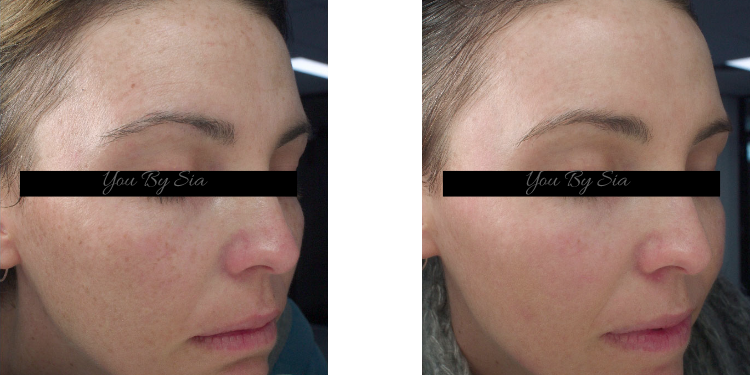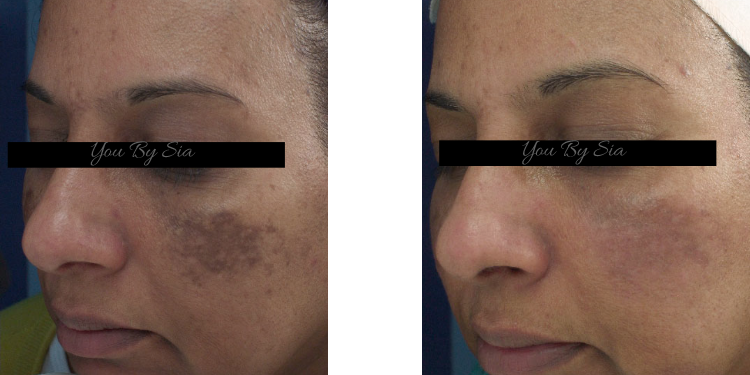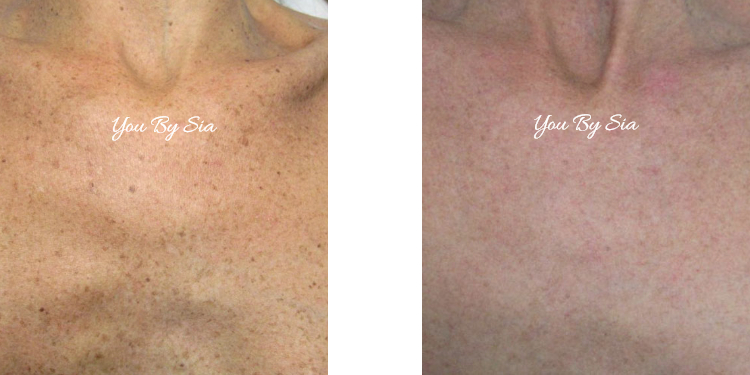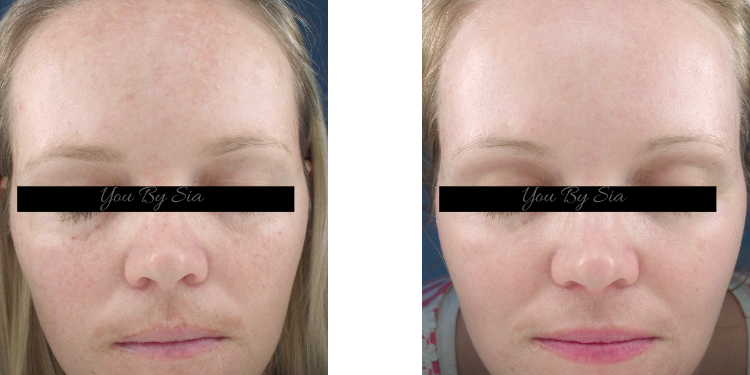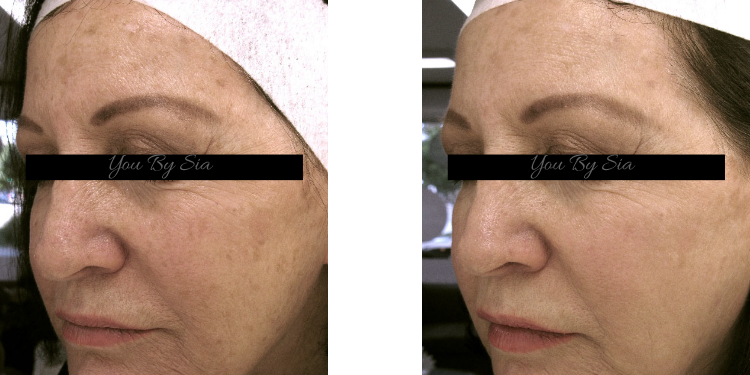
Pigmentation Removal
Home > Pigmentation Removal
Age Spots / Pigmentation Removal
Hyperpigmentation is not necessarily a skin condition but mostly signifies the darker patches that occur on the skin, either in small areas, larger areas, or on the entire body. While increased pigmentation isn’t harmful, it may be a symptom of an underlying disease. In such cases, it becomes crucial to get rid of it with a proper pigmentation removal treatment.
Most clients today experience some form of excess pigmentation in their skin. This is usually due to the most common cause, UV exposure. However, there are multiple reasons beyond this that contribute to the common forms of pigmentation such as freckles, Melasma, Age spots/Liver spots and PIH (Post Inflammatory Hyperpigmentation).
Take a look at the results
How Our Pigmentation Removal Treatment Works
At You By Sia, we have multiple ways of treating different forms of pigmentation using different lasers, LED therapy and topical cosmeceutical skincare. Not ALL skins are able to have a laser treatment and may require only topical solutions. That is why Sia, founder, and owner of our laser clinic in Bondi Junction, specialises in pigmentation removal and will work out the most effective but safe solution to address your pigmentation concerns.
Laser pigmentation removal works by breaking down the pigments and dispersing it into your skin without damaging the surrounding tissue. The melanin, when broken down, can remove the pigmentation from your skin completely; however, it may take more than one session. The pigmented spots will either fade or flake away when the treated area is drawn to the surface.
Call or go online to book an appointment for a one on one consultation with Sia today.
Find out more about the pigmentation removal journey - Watch More
What Causes Pigmentation
The cause of excess pigmentation (hyperpigmentation) in the skin depends on the type. The most common causes of hyperpigmentation are:
Sun Exposure
The body produces additional melanin to protect the skin from prolonged exposure to the sun to prevent cell damage. This can cause dark spots or patches on the skin called age spots, sunspots and solar keratosis.
Skin Inflammation
Areas of skin can darken after people have had a trauma or irritation to the skin including acne, eczema or lupus. The skin releases melanin to assist with the fight against inflammation as an autoimmune response. People with darker skin are more prone to post-inflammatory hyperpigmentation.
Melasma/Chloasma
Darker patches of skin can form when people experience hormonal changes or imbalances. This type of hyperpigmentation is common during pregnancy and even while on the contraceptive pill or implants.
Reactions to drug use
Certain medications, such as antimalarial drugs and tricyclic antidepressants, can cause hyperpigmentation. In these cases, patches of skin may turn grey. Chemicals in topical treatments can also sometimes cause hyperpigmentation.
Medical Conditions
More serious causes of hyperpigmentation include Addison’s disease(affecting the adrenal glands) and hemochromatosis ( iron overload). It can cause hyperpigmentation in certain areas of the body, including:
Folds Of Skin
Lips
Elbows and knees
Knuckles
Toes
Inside of the cheek
Laser Treatment for Pigmentation Removal
It’s important to note that not all skin types are suitable for laser treatments. Post-inflammatory pigmentation is more difficult to address and is not suitable for laser treatment. This form of pigmentation is caused by trauma and can be diminished with You By Sia’s specially formulated pigment inhibitor serum. Clinicals range Shift AM and PM, Erase, Dermafade, Minc can all assist with combating the signs and causes of pigmentation build-up.
Whereas other forms of hyperpigmentation can be addressed with LED therapies and Lasers. You will have an initial assessment and skincare products will be used to prep the skin 2 weeks prior to the laser treatment.
Pricing & Booking
LUXE VIP members - Save 30%
FAQs
-
Pigmentation removal is a cosmetic approach that addresses skin discolouration by lightening or clearing areas of excess pigment. The process involves targeting melanin build-up, which is responsible for dark spots and uneven tone. Treatments may include lasers, light-based devices, or medically formulated creams that break down concentrated pigment. Once disrupted, the pigment gradually disperses or is shed through the skin’s natural renewal cycle, improving overall clarity and balance in skin tone.
-
The most common causes of skin pigmentation and dark spots include:
Hormonal changes: Such as pregnancy or contraceptive use, often causing melasma.
Skin inflammation: From acne, eczema, or injury, which can result in post-inflammatory hyperpigmentation.
Medications: Some drugs may trigger pigmentation changes.
Medical conditions: Disorders like Addison’s disease or hemochromatosis can also cause dark patches.
UV exposure: Prolonged sun exposure stimulates excess melanin production, leading to freckles, sunspots, and uneven skin tone.
-
Laser treatment can significantly reduce or remove pigmentation, but permanent results are not always guaranteed. Factors such as skin type, the cause of pigmentation, and sun exposure after treatment can influence whether pigmentation may return.
-
The number of sessions varies according to the nature and severity of the pigmentation. Shallow pigmentation may respond within a few treatments, while deeper or more stubborn marks often require a longer course. In most cases, several sessions are carried out at intervals of a few weeks to allow the skin to heal and gradually reveal clearer results.
-
Downtime is usually minimal. Some people may experience mild redness, swelling, or flaking in the treated area, which typically settles within a few days. Normal activities can usually be resumed soon after treatment.
-
Laser pigmentation removal may cause mild discomfort, often described as a snapping or tingling sensation on the skin. Most people tolerate it well, and cooling methods are usually applied during treatment to reduce discomfort.
-
Laser technology is effective for treating pigmentation such as sunspots, age spots, freckles, and melasma. However, post-inflammatory hyperpigmentation is usually not treated with lasers and may require topical solutions instead.
-
Pigmentation removal can be safe for many skin types, but not all individuals are suitable candidates for every method. Treatments like laser therapy may carry higher risks for certain skin tones, potentially leading to irritation or uneven pigmentation. This is why a professional consultation is important, as it helps determine the most appropriate and safe approach for each person’s skin.
-
Pigmentation can return after laser treatment if the underlying triggers remain active. Sun exposure, hormonal imbalances, and some medical conditions are common factors that may cause new patches to form. While the procedure helps clear existing marks, following a protective skincare routine and scheduling maintenance sessions when required can help preserve the results for longer.
-
Side effects are generally mild and temporary. They may include redness, swelling, mild irritation, or flaking of the treated area. In some cases, dark spots may temporarily appear darker before fading. These effects usually settle within a few days, and the risk is reduced when treatment is performed by a trained professional.


